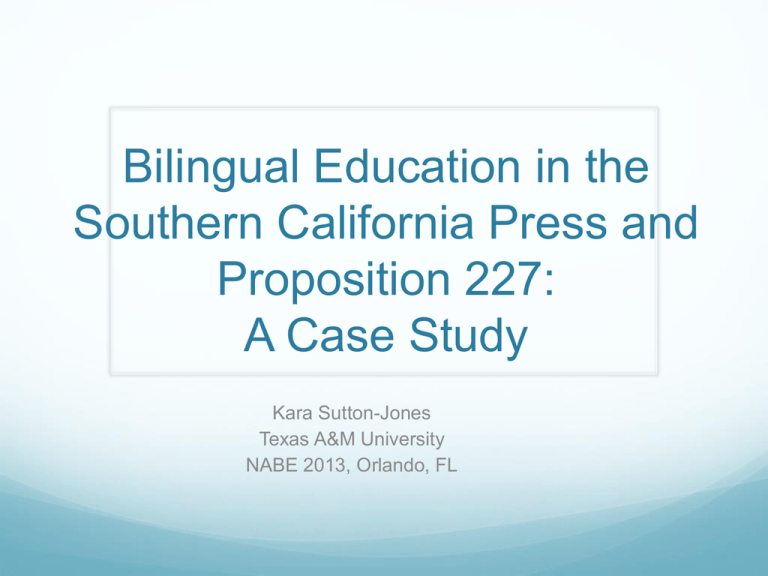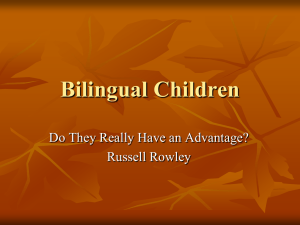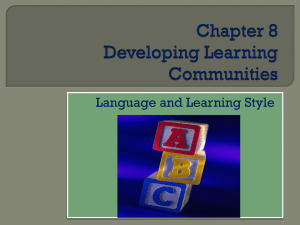Bilingual Education in the Southern California Press and Proposition
advertisement

Bilingual Education in the Southern California Press and Proposition 227: A Case Study Kara Sutton-Jones Texas A&M University NABE 2013, Orlando, FL Background California is home to more than 1.7 million ELL students, with nearly 1,389,624 of them being Spanish speakers (2003 CELDT). California has the highest numbers of ELLs in the country. Although California represents 12% of the nation’s population, California’s schools have more than 40% of the nation’s ELLs (Macias, 2000). Background In the 1980’s and 90’s, California’s growing immigrant population caused a wave of anti-immigration sentiment with voters, resulting in a series of bills targeting immigrants (Olson, 2009). This culminated in the 1998 passage of Proposition 227, which effectively curtailed native-language instruction in the state (Olson, 2009). Proposition 227 The “English for the Children initiative” was supported by Ron Unz, the Silicon Valley businessman and 1994 Republican gubernatorial candidate for California. The initiative was approved by voters with an overwhelming 61% of the vote. Proposition 227 Prop. 227 requires that ELLs transition to English-only instruction after one year of sheltered English immersion, although parental waivers for bilingual education are available in some cases. Roughly one third of California’s ELLs (29%) received some form of bilingual education prior to Prop. 227. That number fell to 11% after the law went into effect (2003 CELDT). Media & Public Knowledge The public’s knowledge of bilingual education and biliteracy is limited and often filled with misconceptions (Wiley, 1997; Crawford, 1998). Media plays an important role in educating and informing the public, in essence shaping public opinion. Many lawmakers rely on newspapers as a key source of information (Weiss & Singer, 1987). Media & Education Research Frequent absence or misrepresentation of relevant educational research in the media, which produces a negative view of education. For example: In one study, the author found that the press frequently referenced a list created by a fundamentalist activist. The list, without any basis in research, compared problems in the education system of the 1940’s with those of the 1980’s (O’Neil, 1994). Another study showed faulty reporting in newspapers and news magazines on poor student achievement over time and in comparison with students from other countries (Bracey, 1995). Media & Education Research Issues with the type and balance of coverage provided. For example: Researchers showed that in the 12 highest circulation U.S. daily newspapers, stories covering education frequently focused on controversy, which the researchers characterized as wrongdoing, impropriety, or policy conflicts. Twenty-one percent of the stories included in the study were one-sided (Simon, Fico, & Lacy, 1989). Some of these issues appear to stem from a combination the how the news industry operates and the nature of educational research. The News Industry Reporters covering education tend to be inexperienced or lack commitment to their assignment. With a high turnover rate (McQuaid, 1989), the education beat is commonly considered an undesirable, entry-level position for young reporters on daily newspapers (Savage, 1989). With news budgets shrinking and staff cuts, education coverage has suffered, especially on U.S. dailies (Petrilli, 2009). Editors expect highly localized articles on schools, not reports on school board meetings or state education legislation (Petrilli, 2009). Journalists are trained to cover big news events, whereas education researchers report their findings in small, incremental steps. Moreover, educational research is primarily written for other educational experts, government specialists, and academic journals (Savage, 1989). Media & Bilingual Education In 1996, McQuillan and Tse conducted a content analysis of education research journals and major U.S. newspapers and news magazines on their coverage of bilingual education. Despite a high number (82%) of research articles showing positive findings on bilingual education’s efficacy, less than half of the popular media opinion pieces took a favorable view of bilingual education. Less than half of the media opinion pieces referred to educational research, while nearly a third utilized anecdotal evidence. Media & Bilingual Education In 2008, Tarasawa compared media coverage on bilingual education from two Atlanta-based newspapers: the mainstream Atlanta Journal Constitution and Atlanta Latino, published in both Spanish and English. She found that more favorable coverage of bilingual education was given by Atlanta Latino. Atlanta Latino also frequently cited educational research in its stories. The Current Study The current qualitative case study investigates the representation of bilingual education in the media, specifically in print outlets in Southern California. Media coverage is an integral part of the formation of public perception. It is important to understand what the media says about bilingual education—in content, tone, and source. Significance & Purpose With few studies on the media’s representation of bilingual education, the current research provides useful information on how bilingual education was portrayed in the media during in the period prior to and after the passage of Prop. 227. This research focused on the daily news as it appeared in three Southern California newspapers because these dailies all represent different political and social perspectives. Additionally, these publications are based in communities with high Latino populations where the issue of bilingual education has significance. Research Questions How is bilingual education represented in the media? Is it shown positively or negatively? What type of claims about bilingual education are made by the media and their sources? Who are the sources of information? What evidence do they provide to substantiate their claims? Methodology Using the ProQuest databases, I investigated the print coverage of bilingual education of three Southern California newspapers, including the Los Angeles Times, The Orange County Register, and La Opinión, for maximal variation in my samples. The timeframe for the search was 1996-2011, and I looked for news, editorials, columns, and letters to the editor touching on bilingual education. I randomly selected 10 representative pieces from each newspaper, and analyzed and coded the content by year, word count, page number, article type, article tone, research cited, research tone, sources, source title, source category, source tone, argument cited, and argument tone. Adapted from McQuillan & Tse, 1996; Tarasawa, 2008 Methodology The coding information was entered into a spreadsheet, color coded, sorted, and counted. For validity and reliability purposes, I sought the input of three current and former California teachers, without any ties to bilingual education. The study was also shared with a peer serving as a bilingual teacher in the state of Texas. I practiced reflexivity (as described by Burke Johnson, 1997) as I wrote. Results Research Question 1: How is bilingual education represented in the media? Is it shown positively or negatively? The English-language dailies, the Los Angeles Times and The Orange County Register, were more likely to run news, opinions, editorials, and letters to the editor that had a negative tone about bilingual education. The Spanish-language paper, La Opinión, was more likely to publish articles (which were longer, more in depth, and more frequent) that took a positive view of bilingual education. La Opinión’s positive view of bilingual education was more consistent after the 1998 passage of Prop. 227 Results Tone toward bilingual education across sampled news, editorials, opinions, and letters to the editor. Note: Percentages are out of the number of articles sampled for each daily (n=10). Results Number of located articles mentioning bilingual education from 1996-2011. Sampled articles’ word count by percentage. Results Article position (page number) within the newspapers. Note: Percentages are out of the number of articles sampled for each daily (n=10). *One Register article did not include a page number. Results The Times and Register were more likely to write about bilingual education in a rather “cut and dry” fashion. These articles tended to lack context or arguments for or against bilingual education. Although the sample of articles from La Opinión included more articles intended as news stories, these articles were more likely to include favorable explanations of bilingual education. This trend could be seen in some of the headlines. For example, the following are from La Opinión: “La educación bilingüe es para aprender inglés” (Fuentes-Salinas, 1997) and “Niño inmigrante necesita de la educación bilingüe” (Linares, 1996). Results Research Question 2: What type of claims about bilingual education are made by the media and their sources? Who are the sources of information? What evidence do they provide to substantiate their claims? The most frequently made argument about bilingual education by both sides of the issue centered on its efficacy for teaching English. Those opposed to bilingual education claimed it is not effective, and those in favor said it is successful. Results The arguments used to support or attack bilingual education varied by the language of the daily. For example, the English-language newspapers were more likely to focus on cost, public opinion, and perceived lack of efficacy as reasons for opposition. On the few occasions where antibilingual education arguments were made, the Spanishlanguage newspaper focused on perceived lack of efficacy and parental choice. Educational research was rarely used by any of the newspapers, but La Opinión utilized it more. The Times and the Register both indirectly cited educational research in 10% of the articles. La Opinión was a little better at 20%. Results Most frequently cited arguments for and against bilingual education by percentage. Note: Percentages are out of the number of total arguments found in the sample for each daily. Results Source type by percentage. Note: The Movement category includes leaders and participants from both the bilingual education opposition group and bilingual education proponent group. Discussion My findings are consistent with earlier research on coverage of bilingual education. English-language/mainstream media outlets tended to oppose bilingual education, while Spanishlanguage outlets favored it. The quality, accuracy, and balance of the information included the reporting on bilingual education in the Englishlanguage dailies during this time period was lacking, suggesting bias. It also implies that the general public reading these newspapers was misinformed on the issue. This has serious implications considering the public uses this information to make voting decisions, such as the “yes” vote on Prop. 227, which impacts the education of thousands of ELLs in the state. Selected References Bracey, G. W. (1995). Disarming information: Ways to counter negative critics. Journal of Educational Public Relations, 16 (1), 2-8. Burke Johnson, R. (Winter 1997). Examining the validity structure of qualitative research. Education, 118(2), 282-292. California Department of Education, 2003 Adequate Yearly Progress Phase I Report, available at http://data1.cde.ca.gov/dataquest/AYP/ 2003AYP_State_p1.asp?cChoice=AYP03_st&cYear=&cLevel=State &cTopic=AYP&myTimeFrame=S&submit1=Submit, accessed 2004a, revised July 6, 2004. Crawford, J. (1997, Winter). The campaign against Proposition 227: A post mortem. Bilingual Research Journal, 21(1), 1-29. Crawford, J. (1998). Ten common fallacies about bilingual education. ERIC Digest. Washington, D.C.: ERIC Clearinghouse on Languages and Linguistics. Fuentes-Salinas, J. (1997, September 28). La educación bilingüe es para aprender inglés: Con ocho años de experienca, el profesor Alfredo Juárez aclara algunos equívocos. La Opinión, 72(13), p. 1C. Selected References Linares, J. J. (1996, November 17). Niño inmigrante necesita de la educación bilingüe: Las personas bilingües se acercan a los problemas con dos visions, dicen expertos. La Opinión, 71(62), p. 1A. Macias, R. (2000). Summary report of the survey of the states’ Limited English Proficient students and available education programs and services, 1997–98. Washington, D.C.: National Clearinghouse for Bilingual Education. McQuillan, J. & Tse, L. (1996). Does research matter? An analysis of media opinion of bilingual education. Bilingual Research Journal: The Journal of the National Association for Bilingual Education, 20(1), 1-27. Olsen, L. (2009, March). The role of advocacy in shaping immigrant education: A California case study. Teachers College Record, 111(3), 817-850. O’Neil, B. (1994, March 6). The history of a hoax. The New York Times Magazine, pp. 46. Selected References Petrilli, M. J. (2009). Disappearing ink. Education Next, 9(4), 83-85. Savage, D. (1989, August). The press and education research: Why one ignores the other. Paper presented at the Colloquium on the Interdependence of Educational Research, Educational Policy, and the Press. Charlottesville, VA. Simon,T. F., Fico, F., & Lacy, S. (1989). Covering conflict and controversy: Measuring balance, fairness, defamation. Journalism Quarterly 427-434. Tarasawa, B. (2008). Mixed messages in media coverage of bilingual education: The case of Atlanta, Georgia. Bilingual Education Journal: The Journal of the National Association for Bilingual Education, 31, 23-46. Weiss, C., & Singer, F. (1987). Reporting of social science in the national media. New York: Russell Sage Foundation. Wiley, T. G. (1997). Myths about language diversity and literacy in the United States. ERIC Digest. Washington, D.C.: ERIC Clearinghouse for ESL Literacy Education. Questions? Thank You! This presentation can be accessed on our website: ldn.tamu.edu. If you would like more information, please contact me at kara.sutton@tamu.edu.







